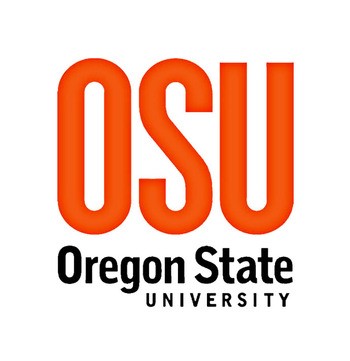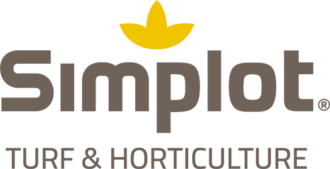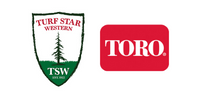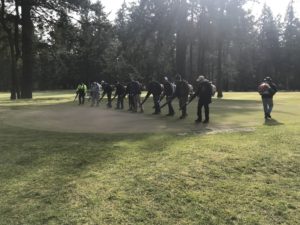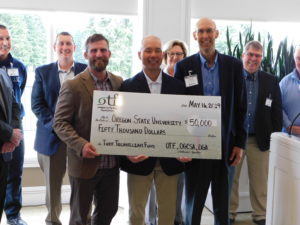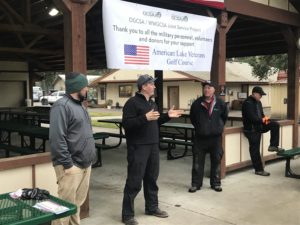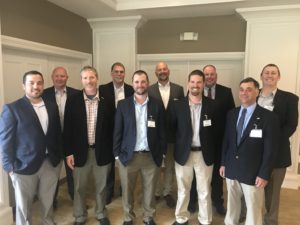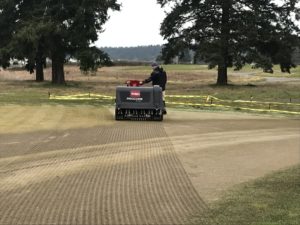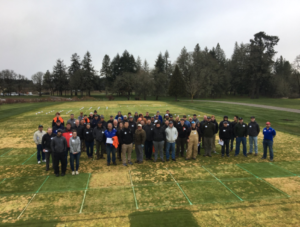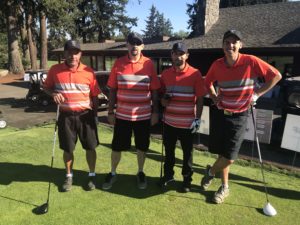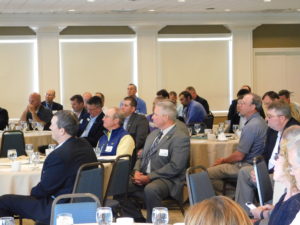2015 OSU Turf Program Report
Annual Report Oregon State University Turfgrass Program Alec Kowalewski, Ph.D.
Turfgrass Specialist
alec.kowalewski@oregonstate.edu
(541)737-5449
Staffing:
Current team members: Alec Kowalewski, Turfgrass Specialist and Brian McDonald, Senior Faculty Research Assistant
General Turf Program Comments:
The two permanent members of the OSU turf program include Turfgrass Specialist Alec Kowalewski and Senior Faculty Research Assistant Brian McDonald. In 2015, with the help of four Graduate Assistants; Clint Mattox, Brian Daviscourt, Micah Gould, and Conner Olsen this team provided 40 Extension teaching events, 19 site visits, 21 proceedings, 5 scientific abstracts, 4 presentations to peers within the scientific community, 7 industry publications, 4 press releases, and 3 peer review journal publications.
The majority of the OSU Turf Program field research is conducted on the 6 acres of Turf Research Plots at the Lewis-Brown Farm, Corvallis, OR, as well as a handful of off-campus research projects hosted by golf courses in the Willamette Valley and Central Oregon. In 2015, this included over 30 industry and grant funded research projects, generating $244,653 in program funds for the year.
Undergraduate Turf Club activities completed in 2015 include, but were not limited to; exhibitor events on a state and national level (3 events), golf outings (2 outings), participation in the GCSAA Collegiate Turf Bowl Competition (1 team), and one community service event (spring aerification and topdressing at the Children’s Course of Oregon, Gladstone, OR).
Teaching Program:
Current undergraduate enrollment (2015): 12 undergraduates
Trend in undergraduate enrollment over last 3 years: 24 students in 2013, and 18 students in 2014.
Placement: 99%
Brief comments on teaching: For students with an interest in turfgrass management, Oregon State University offers undergraduate students a Bachelor’s degree in Horticulture with a Turfgrass Management Option. Within this plan of study, 5 courses are specific to Turfgrass Management. These courses include Principles of Turfgrass Maintenance (HORT 314), Irrigation and Drainage (HORT 360), Pesticide Applicator Training (HORT 405), Turfgrass Internship (HORT 410) and Golf Course Maintenance (HORT 418).
2015 Internships Hosts Included…
Chambers Bay Country Club, University Place, WA
Sun Valley Country Club, Sun Valley, ID
Columbia Edgewater Country Club, Portland, OR
Waverly Country Club, Portland, OR
Pacific Sports Turf, Portland, OR
Current graduate student: Clint Mattox
MS or PhD: Ph.D.
Project(s): Managing Microdochium Patch Using Non-traditional Fungicides
Objective: Explore techniques of controlling Microdochium patch in the absence of fungicides on annual bluegrass putting greens and to further explore modes of action of these techniques.
Findings: 2013-2015 field trials have provided promising results regarding alternative methods of controlling Microdochium patch on annual bluegrass putting greens. Current focus is on refining techniques to provide a comprehensive IPM protocol for the management of Microdochium patch in the absence of fungicides. Further studies focus on exploring the modes of actions of these new management techniques.
Graduation date: December 2018 (Expected)
Funding Source: Oregon Turf Foundation, Oregon GCSA, GCSAA, Western Canada Turfgrass Association/Ontario Turfgrass Research Foundation, and the Northwest Turfgrass Association.
Current graduate student: Brian Daviscourt
MS or PhD: M.S.
Project(s): Life Cycle and Playability Analysis of Natural and Synthetic Athletic Surfaces
Objectives:
- Create and compare the maintenance budgets of 5 natural grass and 5 synthetic fields for a 20 year period.
- Gather field-use hours and calculate the cost of providing an individual with an hour of use in regards to the 20-year life cycle analysis.
Findings: The results 20-year life cycle analysis revealed that synthetic fields were almost twice as expensive as natural grass fields. However the cost of providing an individual with an hour of use was not significantly different because the synthetic fields accommodated a much greater number of player hours thus balancing the large expense of installing, maintaining, and re-carpeting a synthetic field over a 20 year period.
Graduation date: Fall 2016 (Expected)
Funding Source: Oregon State University Department of Athletics, and the Northwest Turf Association
Current graduate student: Micah Gould
MS or PhD: M.S.
Project(s): Low Maintenance Ground Covers for Pacific Northwest Municipalities
Objective: Identify ground covers that can compete with weeds while maintaining aesthetic qualities with minimal maintenance.
Findings: Agrostis capillaris L. (Colonial bentgrass), Festuca rubra L. spp. ‘Commutate’ (Chewings fescue), and Festuca rubra L. spp. ‘Rubra Gaudin’ (Strong creeping red fescue) had the highest plant cover (83%, 76%, and 74% respectively), followed by Sedum spurium ‘Dragon’s blood tricolor’ which provided 51.8% ground cover. A strong inverse correlation between plant ground cover and weed ground cover was identified. Mowing did not affect percent plant or weed ground cover.
Graduation date: Fall 2017 (Expected)
Funding Source: United States Department of Agriculture – National Institute of Food and Agriculture, and OSU Integrated Plant Protection Center
Current graduate student: Conner Olsen
MS or PhD: M.S.
Project(s): Investigating Alternative Irrigation Strategies to Improve Sustainability in Turfgrass
Objectives:
- Prove the efficacy of utilizing reclaimed wastewater for irrigation of rough-length perennial ryegrass, both through the assessment of salt-tolerant cultivars, as well as through seasonal soil and tissue sampling.
- Determine the optimal “set-it-and-forget-it” irrigation schedule for homeowners in the Willamette Valley
Findings: Data collection is currently in progress, however, initial estimates are that salt accumulation may not be a problem for grasses in the Willamette Valley, where annual precipitation could provide sufficient leaching. It has yet to be determined if there is a difference between year-round (i.e. wastewater disposal sites) and supplemental irrigation applications (i.e. summer irrigation of golf courses). It is also thought that through optimizing the watering schedule in terms of application frequency and intensity, acceptable turf quality could be achieved with less water than the current recommendation of 1 inch per week.
Graduation date: Fall 2017 (Expected)
Funding Source: Oregon Turf Foundation, and Oregon Golf Course Superintendents Association
Other notable research projects…
Title: National Fine Fescue Test
Description: Oregon State University is currently a host to the 2015 National Fine Fescue Test.
Funding Source: National Turfgrass Evaluation Program
Title: Effects of Sulfur, Calcium Source and pH on Microdochium Patch
Description: The objectives of this research are to first, determine if elemental sulfur applied with and without various calcium sources can effectively reduce the number of annual fungicide applications necessary to manage Microdochium patch on annual bluegrass; and second, to evaluate the effects of various sulfur applications rates on annual bluegrass health and vigor and incidence of anthracnose. The final objective is to explore potential correlations between soil pH, turf health, and Microdochium patch incidence.
Funding Source: United State Golf Association
Title: Effects of Winter Foot Traffic on an Annual Bluegrass Putting Green in Corvallis, OR.
- As traffic rates (golf rounds per day) increased turf quality and color decreased.
- The higher traffic rates (220 and 440 rounds per day) caused the greatest reduction in turf quality and color observed in February.
- Traffic at the high rate (440 rounds per day) reduced turf quality and color to unacceptable levels in February and March.
- When temperatures are less than 50° F and solar radiation is less than 300 per day, golf rounds should be restricted to 220 rounds per day. In 2016, temperature and solar radiation were consistently above these thresholds beginning in-mid March.
Funding Source: United States Golf Association
Title: The Effects of Mowing Delay on Proxy Efficacy for Poa annua Seed Head Suppression.
- Proxy applications significantly reduced seed head formation and size vs. untreated.
- Mowing on the date of Proxy application reduced Proxy effectiveness on only one rating date – 5 weeks after initial treatment and 11 days after the second application.
- Proxy applications lightened turf color slightly.
- Proxy applications improved turf quality vs. control by significantly reducing visible seed heads.
- In 2016, the protocol will be to include an increased number of mowing delay treatments prior to Proxy application (6, 5, 4, 3, 2 and 1 days prior) and mowing delay treatments after Proxy application (1, 2, 3, 4, 5 and 6 days after).
- Funding Source: United States Golf Association
Sample of Recent Publications:
- Kowalewski, A.R., B.M. Schwartz, A.L. Grimshaw, D.G. Sullivan, and J.B. Peake. 2015. Correlations Between Bermudagrass Hybrid Morphology and Wear Tolerance. HortTechnology. 25(6):725-730.
- Grimshaw, A.L., B.M. Schwartz, P.L. Raymer, A.R. Kowalewski and T.L. Grey. 2015. Influence of soil type on nitrogen leaching of controlled release fertilizers. Florida State Horticultural Society. 127:181-184.
- Kowalewski, A.R., B.M. McDonald and C.M. Mattox. 2015. Evaluation of sulfur rates and calcium sources on Microdochium patch and Anthracnose of an annual bluegrass putting green in western Oregon, 2013 – 2014. Plant Disease Management Reports. 9:T034.
- Goatley, M., R. Maguire, A. Kowalewski and D. Linde. 2015. Utilizing Soil Tests in Nutrient Management for Sports Fields. The Safe Foundation. pg 1-8.
- Kowalewski, A. G. Stahnke, T. Cook and R. Goss. 2015. Best Management Practices for Maintaining Sand-based, Natural Grass Athletic Fields. A Pacific Northwest Extension Publication (PNW676). pg 1-13.
- Kowalewski, A. G. Stahnke, T. Cook and R. Goss. 2015 Best Management Practices for Construction of Sand-based Natural Grass Athletic Fields. A Pacific Northwest Extension Publication (PNW675). pg 1-13.
- Mattox, C., A. Kowalewski and B. McDonald. 2015. Fungicide Alternative Management Practices for Microdochium Patch. TurfLine. September/October 2015. pg 24 and 25.
- McDonald, B.W., C.M. Mattox, D.K. Mosdell and A.R. Kowalewski. 2015. Effects of Spray Nozzle and Fungicide Mobility on Control of Microdochium Patch on an Annual Bluegrass Putting Green. Golf Dom. September 2015. pg 43.
- Mattox, C., A. Kowalewski, B. McDonald. 2015. Influence of Winter Fertility on Microdochium nivale. Golf Dom. 71(4):33.
- Mattox, C., A. Kowalewski, B. McDonald. 2015. Fungicide Alternative Management Practices for Microdochium Patch. Golf Course Management. 83(3):99. Retrieved March 3, 2015. http://gcmdigital.gcsaa.org/i/467557/110.
Extension Program:
Recent State Conferences: 2015 OGCSA Annual Meeting – May 20, 2015; 2015 OSTMA Annual Meeting – February 10, 2015; 2015 OGCSA Annual Pest Management Seminar – December 3, 2015.
Other Recent Extension Activities: 2015 School IPM Coordinator Training; 14 events from February 6, 2015 to August 11, 2015; Cumulative Attendance 427.
Websites and Social Networks:
http://horticulture.oregonstate.edu/group/beaverturf;
http://horticulture.oregonstate.edu/content/alec-kowalewski
http://community.beaverturf.com/
https://twitter.com/OSU_TurfClub
Sample of Recent Press Releases:
- In The Garden – FM News 101 KXL. Mike Darcy talks with Alec Kowalewski about fall maintenance of drought stressed lawns. Broadcast September 5, 2015.
- How to grow a truly “green” Lawn. By Kris Wetherbee. 2015 September/October issue of The American Gardener; American Horticultural Society. pg 28-33.
- Spiff up lawns after a tough summer. By Kym Pokorny. OSU Extension Services, The Oregonian, and the Statesman Journal. Retrieved September 1, 2015.
- http://extension.oregonstate.edu/gardening/node/2419
- http://www.oregonlive.com/hg/index.ssf/2015/08/grass_dead_fix_lawn.html
- http://www.statesmanjournal.com/story/life/2015/08/21/spiff-lawns-tough-summer/32143687/
- A Place Where Watching Grass Grow Is Anything But Boring. By Tom Banse. Northwest News Network/Oregon Public Broadcasting. Retrieved June 8, 2015.
- 29. Grass-free backyard makeover (Show us your remodel). By Janet Eastman. The Oregonian/OregonLive. Retrieved May 28, 2015.
- Lawn-Care Basics: How Much to Cut, Irrigate, Fertilize. By. Dean Fosdick. Associated Press. May 4, 2015. Circulation as of May 6, 2015. 95 million. Traditional News Distribution as of May 6, 2015…
- ABC News, Lawn-Care Basics: How Much to Cut, Irrigate, Fertilize (UMV: 27,996,579)
- Aurora Sentinel, Lawn-Care Basics: How Much to Cut, Irrigate, Fertilize (UMV: N/A)
- Big News Network.com, Lawn-Care Basics: How to Cut, Irrigate, Fertilize (UMV: N/A)
- Cute Daily.net, Lawn-Care Basics: How to Cut, Irrigate, Fertilize (UMV: N/A)
- Madison.com, Lawn-Care Basics: How to Cut, Irrigate, Fertilize (UMV: 678,716)
- Tulsa World.com, Lawn-Care Basics: How to Cut, Irrigate, Fertilize (UMV: 558,254)
- Yahoo News, Lawn-Care Basics: How to Cut, Irrigate, Fertilize (UMV: 65,480,961)
- Turfgrass specialist makes lawns, sports fields greener. By. Denise Ruttan. Capital Press. Retrieved March 14, 2015.
- Lawn maintenance plan can be affordable. By. Kathleen Alaks. The Daily Astorian. Retrieved March 8, 2015.
- What is the best driveway grass? By. Alec Kowalewski. Oregon State University Extension Service. Retrieved January 8, 2015.
- Parts of the Whole: Creating Urban Landscapes. By: Erin Martin. Oregon’s Agricultural Process. Oregon State University Agricultural Experiment Station. Winter 2015. Retrieved January 20, 2015.
Brief comments on Extension:
Major Extension efforts include the development of the following programs…
- Schools IPM Landscaping Project – In collaboration with the OSU Integrated Plant Protection Center, this ongoing project includes the development and implementation of curriculum and workshops on IPM for School Turf and Landscape Management which was and is being offered to schools across the state of Oregon.
- Summer Field Day – The curriculum currently includes a program update presentation, which I deliver during the opening remarks. A take-home proceedings booklet is also provided, which includes the objectives, plot maps, and findings from the featured projects (11 presented in 2015), as well as contact information for industry booth and equipment exhibitors. A field tour was also offered and included presentations by OSU faculty, staff, and graduate students allowing the industry an opportunity to interact with the programs current members. The following is a link to the 2015 Summer Field day proceedings…
- Microdochium Patch Field Day – The first annual Microdochium Patch Field Day took place in March 2016. This event is similar to the summer field day, with the exception of having a unique focus on Microdochium patch research. I deliver opening remarks and a field tour is offered and presented by OSU faculty, staff, and graduate students allowing for dialogue amongst industry and OSU program members. A take-home proceeding booklet is also provided.

